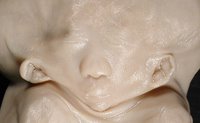A portrait of janiceps
Over the weekend I decided to seize the moment and take pictures of the remarkable preserved specimen that I mentioned in my first post. These little conjoined twins - both female - have evoked a sense of wonder and melancholy in me ever since I first discovered them in a dusty glass jar.
The most complete name for their unfortunate condition is cephalothoracopagus janiceps disymmetros. "Cephalothoracopagus" means that the fetuses are joined at the head and chest; "janiceps disymmetros" means that there are two similar faces, each facing in opposite directions like the Roman god Janus. For me the most curious thing about janiceps is that each face is formed seamlessly from two half-faces, one from each individual! You have to see it to believe it.
The first four photos show the twins from different angles. Click on each image for a larger version. In the position photographed, the specimen measures about 14 cm (5.5 inches) from the top of the head to the bottom of the feet. Below the chest everything looks basically normal except for a little tail on one twin. Unfortunately no other data are available - the specimen belongs to a very old collection that was never properly catalogued.




The next two photos are close-up views of the two faces. The eyelids are barely visible and cannot be opened. To use a clinical euphemism, janiceps is "incompatible with life" - these fetuses most likely died in the womb. A handful of case studies have been reported in the medical literature: for details do a search on "janiceps" at PubMed.






3 Comments:
Your photos are very skillfully rendered. Amazing little girls! I wish we had more information.
Thanks for your site. You read well. You'll make an excellent doctor. You'll keep your patients well informed, presenting them very interesting facts in a very understandable way.
wow you got to love anatomy,as a 2nd year medic i find this extreme variation intriguing as it is only now that am doing embryology in a detailed manner,thanx for the information.
Post a Comment
<< Home